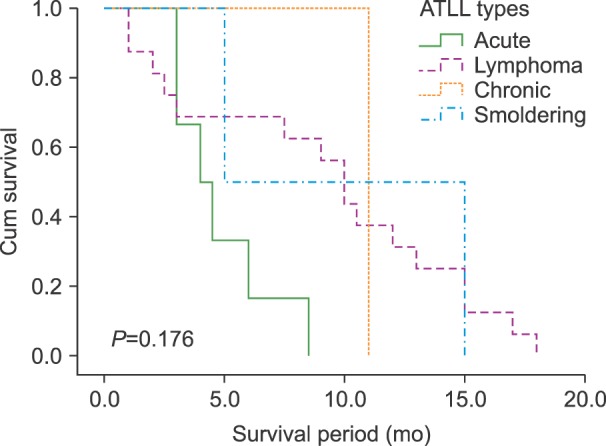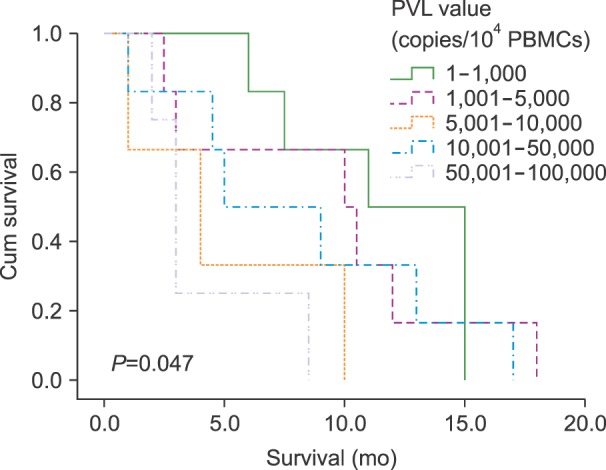Blood Res.
2017 Jun;52(2):106-111. 10.5045/br.2017.52.21.106.
Evaluation of the role of TAX, HBZ, and HTLV-1 proviral load on the survival of ATLL patients
- Affiliations
-
- 1Inflammation and Inflammatory Diseases Research Center, Faculty of Medicine, Mashhad University of Medical sciences, Mashhad, Iran.
- 2Hematology Department, Ghaem Hospital, Faculty of Medicine, Mashhad University of Medical Sciencess, Mashhad, Iran.
- 3Molecular Diagnostic Unit, Research and Education Department, Razavi Hospitals, Mashhad, Iran.
- 4Department of Medical Informatics, Molecular Medicine Department, Faculty of Medicine, Mashhad University of Medical sciences, Mashhad, Iran.
- 5Department of Modern Sciences and Technologies, Molecular Medicine Department, Faculty of Medicine, Mashhad University of Medical sciences, Mashhad, Iran. torshiziR901@mums.ac.ir
- KMID: 2413327
- DOI: http://doi.org/10.5045/br.2017.52.21.106
Abstract
- BACKGROUND
Adult T-cell leukemia/lymphoma (ATLL) is an aggressive malignancy with very poor prognosis and short survival, caused by the human T-lymphotropic virus type-1 (HTLV-1). The HTLV-1 biomarkers trans-activator x (TAX) and HTLV-1 basic leucine zipper factor (HBZ) are main oncogenes and life-threatening elements. This study aimed to assess the role of the TAX and HBZ genes and HTLV-1 proviral load (PVL) in the survival of patients with ATLL.
METHODS
Forty-three HTLV-1-infected individuals, including 18 asymptomatic carriers (AC) and 25 ATLL patients (ATLL), were evaluated between 2011 and 2015. The mRNA expression of TAX and HBZ and the HTLV-1 PVL were measured by quantitative PCR.
RESULTS
Significant differences in the mean expression levels of TAX and HBZ were observed between the two study groups (ATLL and AC, P=0.014 and P=0.000, respectively). In addition, the ATLL group showed a significantly higher PVL than AC (P=0.000). There was a significant negative relationship between PVL and survival among all study groups (P=0.047).
CONCLUSION
The HTLV-1 PVL and expression of TAX and HBZ were higher in the ATLL group than in the AC group. Moreover, a higher PVL was associated with shorter survival time among all ATLL subjects. Therefore, measurement of PVL, TAX, and HBZ may be beneficial for monitoring and predicting HTLV-1-infection outcomes, and PVL may be useful for prognosis assessment of ATLL patients. This research demonstrates the possible correlation between these virological markers and survival in ATLL patients.
Keyword
- HTLV-1; ATLL; TAX; HBZ; Proviral load
MeSH Terms
Figure
Reference
-
1. Gross C, Thoma-Kress AK. Molecular mechanisms of HTLV-1 cell-to-cell transmission. Viruses. 2016; 8:74. PMID: 27005656.
Article2. Gonçalves DU, Proietti FA, Ribas JG, et al. Epidemiology, treatment, and prevention of human T-cell leukemia virus type 1-associated diseases. Clin Microbiol Rev. 2010; 23:577–589. PMID: 20610824.
Article3. Christensen AM, Massiah MA, Turner BG, Sundquist WI, Summers MF. Three-dimensional structure of the HTLV-II matrix protein and comparative analysis of matrix proteins from the different classes of pathogenic human retroviruses. J Mol Biol. 1996; 264:1117–1131. PMID: 9000634.
Article4. Martin JL, Maldonado JO, Mueller JD, Zhang W, Mansky LM. Molecular studies of HTLV-1 replication: An update. Viruses. 2016; 8:pii:E31.
Article5. Lim AG, Maini PK. HTLV-I infection: a dynamic struggle between viral persistence and host immunity. J Theor Biol. 2014; 352:92–108. PMID: 24583256.
Article6. Fuzii HT, da Silva Dias GA, de Barros RJ, Falcão LF, Quaresma JA. Immunopathogenesis of HTLV-1-assoaciated myelopathy/tropical spastic paraparesis (HAM/TSP). Life Sci. 2014; 104:9–14. PMID: 24704970.
Article7. Cabrera ME, Labra S, Catovsky D, et al. HTLV-I positive adult T-cell leukaemia/lymphoma (ATLL) in Chile. Leukemia. 1994; 8:1763–1767. PMID: 7934173.8. Takatsuki K, Yamaguchi K, Kawano F, et al. Clinical aspects of adult T-cell leukemia/lymphoma (ATL). Princess Takamatsu Symp. 1984; 15:51–57. PMID: 6152759.9. Wang C, Yao Z, Liao J, et al. Clinicopathologic, immunophenotypic and ultrastructrual analyses of ATLL patients with cutaneous involvement. Chin Med J (Engl). 1999; 112:461–465. PMID: 11593520.10. Tsukasaki K. Adult T cell leukemia-lymphoma (ATL). Nihon Rinsho. 2014; 72:531–537. PMID: 24724415.11. Mori N. Cell signaling modifiers for molecular targeted therapy in ATLL. Front Biosci (Landmark Ed). 2009; 14:1479–1489. PMID: 19273141.
Article12. Hatta Y, Koeffler HP. Role of tumor suppressor genes in the development of adult T cell leukemia/lymphoma (ATLL). Leukemia. 2002; 16:1069–1085. PMID: 12040438.
Article13. Nicot C. HTLV-I Tax-mediated inactivation of cell cycle checkpoints and DNA repair pathways contribute to cellular transformation: “A Random Mutagenesis Model”. J Cancer Sci. 2015; 2.
Article14. Enose-Akahata Y, Abrams A, Massoud R, et al. Humoral immune response to HTLV-1 basic leucine zipper factor (HBZ) in HTLV-1-infected individuals. Retrovirology. 2013; 10:19. PMID: 23405908.
Article15. Magri MC, Costa EA, Caterino-de-Araujo A. LTR point mutations in the Tax-responsive elements of HTLV-1 isolates from HIV/HTLV-1-coinfected patients. Virol J. 2012; 9:184. PMID: 22947305.
Article16. Ishikawa C, Nakachi S, Senba M, Sugai M, Mori N. Activation of AID by human T-cell leukemia virus Tax oncoprotein and the possible role of its constitutive expression in ATL genesis. Carcinogenesis. 2011; 32:110–119. PMID: 20974684.
Article17. Shiohama Y, Naito T, Matsuzaki T, et al. Absolute quantification of HTLV-1 basic leucine zipper factor (HBZ) protein and its plasma antibody in HTLV-1 infected individuals with different clinical status. Retrovirology. 2016; 13:29. PMID: 27117327.
Article18. Shimoyama M. Diagnostic criteria and classification of clinical subtypes of adult T-cell leukaemia-lymphoma. A report from the Lymphoma Study Group (1984-87). Br J Haematol. 1991; 79:428–437. PMID: 1751370.19. Dearden CE, Johnson R, Pettengell R, et al. Guidelines for the management of mature T-cell and NK-cell neoplasms (excluding cutaneous T-cell lymphoma). Br J Haematol. 2011; 153:451–485. PMID: 21480860.
Article20. Yared JA, Kimball AS. Optimizing management of patients with adult T cell leukemia-lymphoma. Cancers (Basel). 2015; 7:2318–2329. PMID: 26610571.
Article21. Kozako T, Arima N, Toji S, et al. Reduced frequency, diversity, and function of human T cell leukemia virus type 1-specific CD8+ T cell in adult T cell leukemia patients. J Immunol. 2006; 177:5718–5726. PMID: 17015761.22. Clerc I, Hivin P, Rubbo PA, Lemasson I, Barbeau B, Mesnard JM. Propensity for HBZ-SP1 isoform of HTLV-I to inhibit c-Jun activity correlates with sequestration of c-Jun into nuclear bodies rather than inhibition of its DNA-binding activity. Virology. 2009; 391:195–202. PMID: 19595408.
Article23. Satou Y, Yasunaga J, Yoshida M, Matsuoka M. HTLV-I basic leucine zipper factor gene mRNA supports proliferation of adult T cell leukemia cells. Proc Natl Acad Sci U S A. 2006; 103:720–725. PMID: 16407133.
Article24. Tamura K, Nagamine N, Araki Y, et al. Clinical analysis of 33 patients with adult T-cell leukemia (ATL)-diagnostic criteria and significance of high- and low-risk ATL. Int J Cancer. 1986; 37:335–341. PMID: 3005175.
Article25. Lee SY, Cheng V, Rodger D, Rao N. Clinical and laboratory characteristics of ocular syphilis: a new face in the era of HIV co-infection. J Ophthalmic Inflamm Infect. 2015; 5:56. PMID: 26297110.
Article26. Massey AC, Weinstein DL, Petri WA, Williams ME, Hess CE. ATLL complicated by strongyloidiasis and isosporiasis: case report. Va Med Q. 1990; 117:311–316. PMID: 2375179.27. Senba M, Kawai K. Metastatic calcification due to hypercalcemia in adult T-cell leukemia-lymphoma (ATLL). Zentralbl Pathol. 1991; 137:341–345. PMID: 1768685.
- Full Text Links
- Actions
-
Cited
- CITED
-
- Close
- Share
- Similar articles
-
- Adult T cell leukemia/lymphoma with lymphopenia in a Korean
- A Case of Adult T-cell leukemia / lymphoma
- The Role of NF-kappaB RelA Subunit for Tax-inhibition of p53 Transcriptional Activity in Human T-cell Lymphotrophic Virus Type 1
- A Case of Adult T-cell Leukemia/Lymphoma
- A Case of Cytomegalovirus Colitis in Chronic Adult T-Cell Leukemia/Lymphoma



